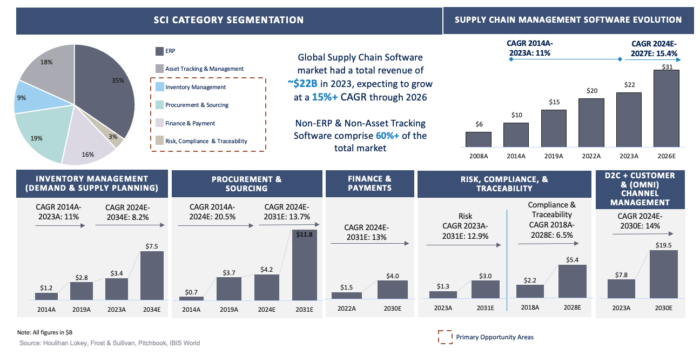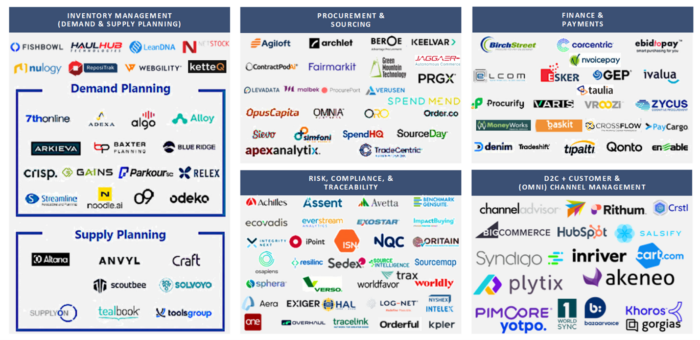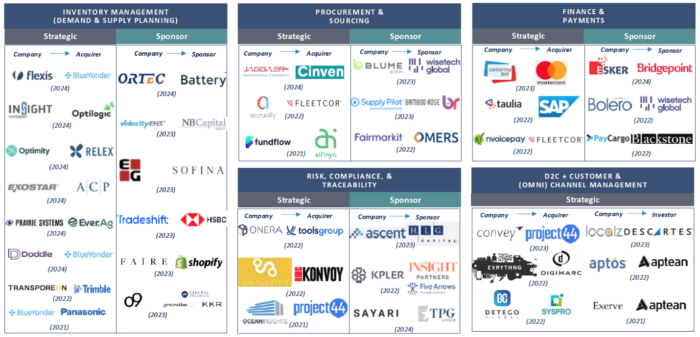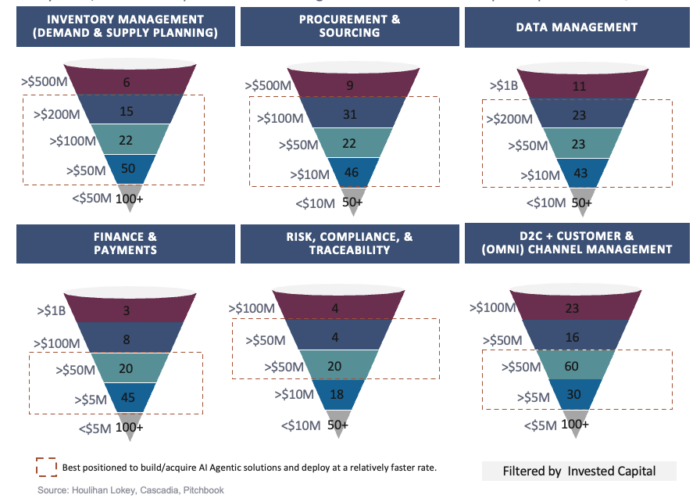Attacking the Belly of the Beast: How AI-First Startups Can Solve Supply & Demand Planning
Bivek Adhikari — December 27, 2024
Picture this: It is mid- November, and you are managing a complex global retail supply chain, preparing for the holiday season’s rush. Demand is soaring, and the pressure is mounting. A single hiccup—whether it is a delayed shipment, a supplier issue, or an unexpected surge in demand—could send shockwaves through your carefully coordinated network, disrupting inventory and production schedules across regions. Despite having access to vast amounts of data, your decisions are based on outdated forecasts and reactive processes that fail to capture the real-time dynamics needed to navigate today’s complex global supply chain. Unfortunately, this is still the reality for many businesses, as over 50% of the largest U.S. importers continue to rely on spreadsheets.
Now, imagine an AI-powered solution that not only predicts demand but also anticipates supply-side disruptions and provides prescriptive insights—all in real-time. This is the potential of AI-driven supply chain intelligence (SCI), but it remains largely unrealized particularly in the critical area of demand and supply planning. This core challenge, the “belly of the beast” in supply chain management, is where startups can make the biggest impact, transforming an entire industry and unlocking unprecedented operational resilience.

A vision of an enterprise architecture for demand and supply planning: a system of AI agents.
Problem: Service-Heavy Solutions Dominate Supply and Demand Planning
We believe consulting giants like Accenture, McKinsey & Company, and Deloitte dominate today’s supply chain landscape, offering high-touch, customized solutions to help companies manage inventory, forecast demand shifts, and mitigate risks. While effective, these services often come at a high cost, involve long timelines, and may have limited scale. In an era where disruptions have become more frequent and unpredictable, this approach is no longer sustainable.
Foundation Capital’s equating of the rise of AI Agents to an evolution from static Software-as-a-Service to what they term Service-as-Software is particularly relevant in supply chain. This shift brings the responsibility for achieving business outcomes onto the AI systems themselves, making them invaluable in timely demand and supply planning. McKinsey reports that 90% of IT leaders are aiming to overhaul their supply chain planning systems. However, the market lacks a truly productized, AI-first solution capable of real-time demand and supply planning at scale. This gap underscores an enormous market opportunity for startups to introduce scalable, automated platforms that can replace traditional service-heavy models. The SCI market has been steadily growing, reaching $22 billion in 2023 with expectations to hit a 15.4% CAGR through 2026.(1) However, demand and supply planning remains dominated by bespoke consulting services, leaving a significant white space for AI-driven, productized solutions.
Why Supply and Demand Planning is the “Belly of the Beast”
Supply and demand planning is one of the most complex aspects of supply chain management. It requires real-time data integration from multiple sources—historical sales data, market trends, weather patterns, economic conditions—then translates this data into actionable insights for inventory and production schedules across global operations. Traditional systems, designed more for stability than adaptability, struggle with the agility needed to manage this vast data integration.
As Ajay Agarwal and Zeeza Cole from Bain Capital Ventures stated in their thesis, moving beyond legacy Electronic Data Interchange (EDI) systems—which were revolutionary in the 1970s but now hinder agility—is key. AI solutions bring the benefit of adaptable, real-time insights that are difficult to achieve with static, rules-based systems like EDI. McKinsey estimates that effective demand and supply planning can reduce out-of-stock rates by up to 65% and slash excess inventory by up to 30%. These statistics underscore the impact that automated, AI-powered solutions could have on supply chain management. Yet, most solutions remain tied to consulting-led models that limit scalability, flexibility, and affordability.
Vertical specific planning issues, as demonstrated in food waste and sustainability challenges, also demand a more dynamic solution. For example, in the food industry alone, supply chain inefficiencies contribute to over , with perishability, seasonality, and transportation hurdles amplifying losses. Solutions that can reduce overage by accurately forecasting demand and synchronizing supply could significantly cut waste and enhance sustainability—a growing imperative across industries.

Supply chain intelligence along with D2C & customer channel management markets add up to a $20B+ target market size growing at 10%-15% across the board.
The Evolution from EDI to AI-Driven Supply Chain Planning
The concept of EDI, which emerged in the 1970s, was revolutionary for supply chains, enabling companies to exchange documents electronically and reduce manual errors. However, EDI introduced new complexities: industries adopted different standards, leading to interoperability issues that persist today. As SCI has grown at 11% CAGR over the past decade, moving away from EDI to real-time, cloud-based solutions have become essential.
In today’s supply chains, data remains fragmented across silos—some data is stored on-premises, some in cloud environments—with systems operating independently. This fragmentation leads to friction and inefficiencies. To deliver real-time forecasting, companies need a unified platform that integrates these disparate data sources. However, data is frequently inconsistent, unstructured, and fragmented, making real-time planning challenging.
Talks with Startups: A Push Toward Tackling the Core
In my conversations with point-solution startups, I have repeatedly emphasized the importance of attacking the “belly of the beast,” instead of focusing on a single pain point first and building out the solutions set from there on. Zip Co, which raised $190M in October 2024 at $2.01B pre-money, is launching a procurement orchestration platform to simplify the complexities of supply chain management. Similarly, companies like Orderful, Noodle.ai, Chain.io, Crstl, Crisp, GrubMarket Inc., and Keelvar are tackling niche areas like EDI modernization, procurement automation, inventory optimization, and supplier risk.
Most startups begin by solving niche problems within procurement, sourcing, finance automation, or risk management because they are easier to address and offer quicker wins. However, attacking the core problem—demand and supply planning—could unlock far greater value across entire supply chains. Benjamin Fels from Pendulum Systems and Sanjay Saini from Stemly, for example, are pursuing demand and supply planning more directly. Pendulum is taking an incremental approach, initially providing services while setting sights on eventual productization. This method allows them to build foundational understanding and capabilities before committing to fully automated solutions.

Market map of growth stage incumbents and emerging players in the SCI space.
Due to these varying approaches, the white space remains unfilled—no company has yet developed an integrated, AI-driven platform that addresses real-time demand and supply planning on a global scale. As noted by Ajay Agarwal and Zeeza Cole from Bain Capital Ventures, To truly disrupt global supply chains, startups need to think bigger and build platforms that address end-to-end visibility and decision-making across all functions—from raw materials sourcing to the final delivery.
Start Small with Low-Resistance Integration Points
For early-stage startups looking to break into SCI, tackling the data integration challenge in one sweeping move can be overwhelming. An effective approach is to focus on low-resistance integration points, laying the groundwork for a scalable foundation. The key steps include:
Integrate with Accessible Data Sources First: Start with cloud-based tools and open APIs from logistics providers. This builds an initial layer of accessible data, creating foundational pipelines for future growth.
Map the Data Ecosystem Gradually: Develop system diagrams to map each integration point, creating a clear view of data flows across the supply chain.
Automate Data Cleansing and Standardization: Implement automated tools to clean and standardize data, ensuring it’s consistent and actionable.
Build a Broker Layer: Create a broker layer that standardizes data across systems, enabling real-time data flow that can support advanced predictive models.
Add a Predictive Modeling Layer: Leverage a service layer that taps into optimized and expert-driven machine learning (ML), neural networks, and other advanced predictive AI models. This layer can accurately forecast demand and supply by drawing from the cleaned, standardized data alongside external vendor data, producing detailed predictions.
The predictive modeling layer outputs data insights that can be fed directly into an AI Agent, enabling it to act on real-time forecasts and make decisions autonomously. With this structured foundation, startups can progressively scale an ecosystem for demand and supply planning, transforming complex and siloed data into a cohesive, predictive real-time network.
The AI agent software ecosystem has developed significantly in the past few months with progress in memory, tool usage, secure execution, and deployment. Below is an enterprise architecture diagram and a standard enterprise AI stack that can be used in SCI use cases.

SCI can, to a greater extent, use the standard Agentic architecture as a part of its AI Orchestration layer. The enterprise application stack diagram, drawn from a16z’s paper on LLM architecture, is also adaptable for other transformer-based use cases.

Comprehensive AI Agents Stack and Market Map: A detailed overview of key layers and capabilities for seamlessly adopting and integrating agentic solutions into SCI (source: a16z, Menlo Ventures, Letta).
Why Now: Moving from “No Phone” to a “Smartphone”
Imagine trying to manage your supply chain with nothing but disparate spreadsheets and outdated reports. It is akin to trying to communicate without a phone. The leap from today’s disjointed systems to an AI-enabled, natural language solution is like going from no phone to an advanced smartphone. Just as a smartphone integrates voice, messaging, internet, and apps into one seamless experience, an AI-driven platform would unify inventory, procurement, logistics, and real-time demand sensing into a single, accessible tool.
Such a system wouldn’t just offer insights—it would automate key decisions and actions based on real-time data, empowering supply chain managers with a level of precision and agility that feels as intuitive as using a smartphone. The shift is overdue, and the tools needed to make this transformation are now within reach.
Vertical AI: Industry-Specific Solutions as a Differentiator
Vertical AI will be instrumental in tailoring solutions for specific industries, where supply chain dynamics and needs vary. For instance:
Food and Beverage: The food industry has unique challenges, including perishability, seasonality, and fluctuating consumer preferences. has demonstrated its value in addressing industry-specific complexities by helping companies to reduce food waste and optimize production using real-time demand insights. This not only saves time and money, but also minimizes food loss, creating more efficient and sustainable operations.
Consumer Electronics: The consumer electronics sector is characterized by component shortages and rapid product cycles leading to complex planning needs. Vertical AI models designed for electronics can forecast demand and supply fluctuations, allowing manufacturers to maintain optimal inventory levels without overstocking or risking out-of-stock situations.
By focusing on vertical-specific AI, startups can provide nuanced solutions that address the unique challenges and priorities of each industry. This approach is essential for developing solutions that create real, sustainable value.
Rapid Growth and Multiple Exit Opportunities
The SCI market is growing at a record pace, driven by its high fragmentation and increased demand for real-time, integrated solutions. Supply chain software has traded with lower volatility and at a higher multiple than SaaS comparables across both public and private markets. In 2023, publicly traded supply chain management software saw a The M&A market has been active, with as companies seek to build, acquire, or enhance their AI-driven capabilities, according to data from Pitchbook.
Notable acquisitions underscore this trend:
- project44 acquired Ocean Insight for $45 million, boosting its capabilities in ocean freight visibility.
- Trimble Inc.’s $2.1 billion acquisition of Transporeon expanded its real-time logistics management solutions.
- Coupa Software acquired LLamasoft for $1.5 billion, enhancing its AI-driven supply chain planning capabilities, which led to its subsequent $8 billion buyout by Thoma Bravo in early 2023.
Investors see tremendous potential in SCI,. Firms like Bain Capital Ventures, which invested $200 million in ShipBob in 2021, recognize the opportunity to capitalize on an industry undergoing rapid digital transformation. Given that for critical supply chain processes, the demand for automated, productized solutions is poised for significant growth. As Jaya Gupta and Ashu Garg from Foundation Capital estimate, AI-enabled supply chain solutions are tackling a $62 billion market opportunity, with vast potential across procurement, demand planning, and supplier intelligence.

Recent M&A and sponsor activities by segment.
For startups, this dynamic creates multiple pathways to scale and exit. A robust SCI platform that can address integration and real-time planning at scale has strong potential for both acquisition by strategic players and substantial investor interest. The high demand for cohesive solutions that bridge disparate data sources, enhance supply chain visibility, and support AI-driven decision-making, positions a successful integration platform as a valuable target. Despite the challenge, solutions that effectively tackle this problem attract a broad array of buyers eager to deepen their digital capabilities and investors looking to capture the market’s rapid growth.
How Startups Can Lead the SCI Transformation
To redefine SCI, startups must focus on building scalable, productized AI solutions that unify demand and supply planning in real time. Startups should prioritize three critical capabilities:
- End-to-End Visibility: A unified platform that consolidates demand, inventory, procurement, and logistics will deliver the holistic insights needed to optimize operations.
- Real-Time Demand Sensing and Supply Disruption Detection: AI-driven demand sensing can empower companies to adapt to changes as they occur, creating a proactive approach to supply chain management.
- Automated Decision-Making: Automating critical decisions—like adjusting production schedules or rerouting shipments based on real-time data—will reduce manual intervention, streamline processes, and improve responsiveness.

Long tail of hundreds of M&A and Agentic disruption ripe companies under $50M in invested capital.
The Time for AI-Driven Supply Chain Planning Solutions is Now
The SCI market is ripe for transformation. I believe consulting-led models are losing relevance as companies seek scalable, productized solutions that enable real-time demand and supply planning. Startups have the chance to redefine the landscape by attacking the core of the problem, addressing the “belly of the beast” with AI-driven solutions that integrate across supply chain functions.
For those who act now, the opportunity is vast. The shift from fragmented, reactive planning to a cohesive, AI-driven, real-time ecosystem is akin to moving from a world with no phones to one with smartphones—seamless, connected, and always accessible. Now is the time for AI-first startups to lead this transformation and usher in a new era of intelligent, resilient supply chains.
—
About the Author: Bivek Adhikari is an MBA Fellow at GroundForce Capital. He is a tech investor with a strong data science background, focusing on early-stage as well as Series B‑C companies. He recently dedicated over 4,000 hours to researching the state of supply chain technologies. This involved engaging with startup founders, incumbent operators, industry veterans/experts, emerging growth stage companies, investment bankers executing M&A deals, consulting firms, prospective early-stage, distressed and defunct companies as well as growth leads, fellow investors tracking the space and key players, end users and customers from different CPG brands, executives from various companies, and independent consultants advising Fortune 500 companies, among other stakeholders.
If you are a builder who is currently working on or interested in building in this space, he’d love to speak with you. He is also happy to chat if you are interested in supply chain technologies but unsure about white spaces. You can reach him at bivek@groundforcecapital.com.
Source:
(1)Analysis based on a detailed model built using data from over 30 sources, including MarketsandMarkets, Fortune Business Insights, and Grand View Research.



